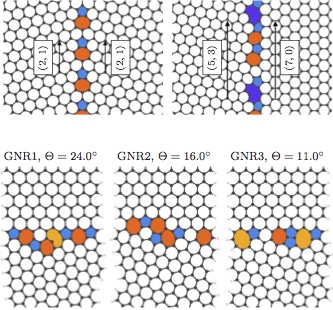Grain boundaries are commonly observed in carbon nanostructures, but their influence on thermal and electric properties is still not completely understood. Using a combined approach of density functional tight-binding theory and nonequilibrium Green functions we investigate electron and phonon transport in carbon-based systems. In this work, quantum transport and thermoelectric properties are summarized for graphene sheets, graphene nanoribbons, and carbon nanotubes with a variety of grain boundary types in a wide temperature range. Motivated by previous findings that disorder scatters phonons more effectively than electrons, a significant improvement in the thermoelectric performance for polycrystalline systems is expected. As the effect is marginally sensitive to the grain boundary type, we demonstrate that grain boundaries are a viable tool to greatly enhance the figure of merit, paving the way for the design of new thermoelectric materials.

Grain boundaries are commonly observed in carbon nanostructures, but their influence on thermal and electric properties is still not completely understood. Using a combined approach of density functional tight-binding theory and nonequilibrium Green functions we investigate electron and phonon transport in carbon-based systems. In this work, quantum transport and thermoelectric properties are summarized for graphene sheets, graphene nanoribbons, and carbon nanotubes with a variety of grain boundary types in a wide temperature range. Motivated by previous findings that disorder scatters phonons more effectively than electrons, a significant improvement in the thermoelectric performance for polycrystalline systems is expected. As the effect is marginally sensitive to the grain boundary type, we demonstrate that grain boundaries are a viable tool to greatly enhance the figure of merit, paving the way for the design of new thermoelectric materials.
